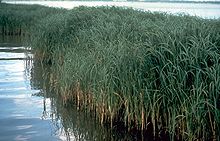- Spartina
-
For the production company, see Spartina Productions.
Spartina 
A clump of Spartina alterniflora Scientific classification Kingdom: Plantae (unranked): Angiosperms (unranked): Monocots (unranked): Commelinids Order: Poales Family: Poaceae Subfamily: Chloridoideae Tribe: Zoysieae Genus: Spartina
Schreb.[1]Species Various, see text.
Synonyms Chauvinia Steud.
Limnetis Rich.
Ponceletia Thouars
Psammophila Schult.
Solenachne Steud.
Trachynotia Michx.
Tristania Poir., nom. inval.[1]Spartina, commonly known as cordgrass or cord-grass,[2] is a genus of 14 species of grasses in the family Poaceae. They are native to the coasts of the Atlantic Ocean in western and southern Europe, northwest and southern Africa, the Americas and the southern Atlantic Ocean islands; one or two species also occur on the North American Pacific Ocean coast and in freshwater habitats inland in the Americas. The highest species diversity is on the east coasts of North America and South America, particularly Florida.
They form large, often dense colonies, particularly on coastal salt marshes, and grow quickly. The species vary in size from 0.3-2 m tall. Many of the species will produce hybrids if they come into contact.
Contents
Selected species and hybrids
- Spartina alterniflora Jean Louis August Loiseleur-Deslongchamps|Loisel. – Smooth Cordgrass (eastern North America)
- Spartina anglica C.E.Hubb. – Common Cordgrass (cultivated origin)
- Spartina bakeri Merr. – Sand Cordgrass
- Spartina × caespitosa A.A.Eaton – Short Cordgrass
- Spartina cynosuroides (L.) Roth – Big Cordgrass
- Spartina densiflora Brongn. – Denseflower Cordgrass
- Spartina foliosa Trin. – California Cordgrass
- Spartina gracilis Trin. – Alkali Cordgrass
- Spartina maritima (Curtis) Fernald – Small Cordgrass (western Europe)
- Spartina patens (Aiton) Muhl – Saltmeadow Cordgrass
- Spartina pectinata Bosc ex Link – Prairie Cordgrass (central North America; freshwater)
- Spartina spartinae (Trin.) Merr. ex Hitchc. – Gulf Cordgrass
- Spartina × townsendii H.Groves & J.Groves (S. alterniflora × S. maritima) – Townsend's Cordgrass[2][3]
Cultivation
Spartina has been planted by humans to reclaim estuarine areas for stripping, to supply feed for livestock, and to prevent erosion. Various members of the genus (especially Spartina alterniflora and its derivatives, Spartina anglica and Spartina × townsendii) have spread outside of their native boundaries and become invasive.
Ecology
Spartina species are used as food plants by the larvae of some Lepidoptera species including Aaron's Skipper (which feeds exclusively on Smooth Cordgrass) and Engrailed.
As an invasive species
Three of the Spartina species have become invasive plants in some countries
See also
- Sand Bay - an area in the UK where Spartina grass planted to support a river bank has spread.
- Invasive grasses of North America
References
- ^ a b "Genus: Spartina Schreb.". Germplasm Resources Information Network. United States Department of Agriculture. 2011-02-27. http://www.ars-grin.gov/cgi-bin/npgs/html/genus.pl?11328. Retrieved 2011-03-03.
- ^ a b "Spartina". Integrated Taxonomic Information System. http://www.itis.gov/servlet/SingleRpt/SingleRpt?search_topic=TSN&search_value=41266. Retrieved 2011-03-03.
- ^ "GRIN Species Records of Spartina". Germplasm Resources Information Network. United States Department of Agriculture. http://www.ars-grin.gov/cgi-bin/npgs/html/splist.pl?11328. Retrieved 2011-02-25.
External links
Categories:- Chloridoideae
- Halophytes
- Poaceae genera
- Invasive plant species
Wikimedia Foundation. 2010.
